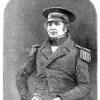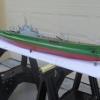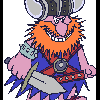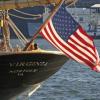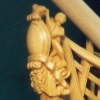MORE HANDBOOKS ARE ON THEIR WAY! We will let you know when they get here.
×
-
Posts
410 -
Joined
-
Last visited
Reputation Activity
-
 Erebus and Terror reacted to Dan Vadas in HMVS Cerberus 1870 by Dan Vadas - FINISHED - Paper Shipwright - 1:250 - CARD
Erebus and Terror reacted to Dan Vadas in HMVS Cerberus 1870 by Dan Vadas - FINISHED - Paper Shipwright - 1:250 - CARD
Thanks for looking in John and Rick.
The finished Rollers. The one on the right has had the CA/sanding treatment and been dry-brushed with black acrylic. It looks 100% better than before :
All four fitted to the deck :
Danny
-
 Erebus and Terror reacted to Dan Vadas in HMVS Cerberus 1870 by Dan Vadas - FINISHED - Paper Shipwright - 1:250 - CARD
Erebus and Terror reacted to Dan Vadas in HMVS Cerberus 1870 by Dan Vadas - FINISHED - Paper Shipwright - 1:250 - CARD
Thanks Popeye, I've used nail clippers on the odd occasion before.
I've made the two Gun Turrets. I used a piece of scrap Castello to make a support for the base. This is slightly smaller than the finished diameter as I want to wrap the sides under the top for a better finish on the join :
I cut two slots into the timber to house the gun barrels, which I made from some aluminium tubing I had lying around. These were painted matt black after this pic was taken, and then glued to the base with PVA :
After gluing on the side and top I trimmed off the slight overlap using a variation on Slog's method whereby I rested the TIP of the blade on the cutting mat and chopped off tiny slivers while rotating the turret. It was a bit easier to do this way as I couldn't see the piece I was cutting with the BASE of the blade on the mat due to the height of the turret :
Not too bad at all . Note the Vents have been fitted UNDER the top for a bit of depth :
One turret fitted to the deck. The ventilators etc will be fitted next - they would have been badly damaged if fitted at an earlier stage :
Here's a question, probably for Slog - I've used a Faber Castell PITT marker to edge colour the sides of the hull/deck joint. It all worked fine until I got just over one side done and the tip dried up. Any tips on getting the ink running again?
Danny
-
 Erebus and Terror reacted to Dan Vadas in HMVS Cerberus 1870 by Dan Vadas - FINISHED - Paper Shipwright - 1:250 - CARD
Erebus and Terror reacted to Dan Vadas in HMVS Cerberus 1870 by Dan Vadas - FINISHED - Paper Shipwright - 1:250 - CARD
Hi all,
With my small distraction (the Concord Stagecoach) finished and out of the way, it's time to get back into SHIP modelling .
I've decided to go in a new direction, both in the Period of the Ship and in it's Construction. I've decided to try my hand at Card Modelling, something I haven't done since I was in my early teens when I built a number of Card models of buildings for my model railway. It was fun at the time, the models turned out OK, and it will hopefully be the same again .
For my first I've downloaded a freebie from Paper Shipwrights of the HMVS (Her Majesty's Victorian Ship) Cerberus. A pre-printed version is available for £8.50 plus p&h, but I had mine done at a local Photocopy shop for around the same price. They used the equivalent thicknesses of paper needed, and I got two copies of each page to cover the inevitable Oopsies.
I also have a Swann-Morton scalpel handle and 100 blades on it's way. The rest of the tools needed I already have :
A small steel rule, a cutting mat (although i might update that, I bought it 10 years ago and it's seen a bit of work ), good tweezers, Q-tips, a glue bottle of PVA, CA Glue for the PE, small side-cutters, pin-vices and micro-drills, a mechanical pencil, hairclip clamps, headband magnifier, a small awl and Tamiya masking tape :
Beats the hell out of the thousands of dollars worth of tools and machines I've accumulated over the years for Wooden Ship Modelling. And .... there's NO sawdust .
If I make a success of this one, I might try my hand at something a little more difficult - either a Bismark or a Yamato . The Build Log starts in the next Post.
Danny
-
 Erebus and Terror got a reaction from mtaylor in HM Cutter Cheerful 1806 by Chuck - FINISHED - 1:48 scale - kit prototype
Erebus and Terror got a reaction from mtaylor in HM Cutter Cheerful 1806 by Chuck - FINISHED - 1:48 scale - kit prototype
This was a simply epic topic and a brilliant result. It's been a masterclass in model building and kit design. Thanks so much, Chuck. Can't wait for the next one.
-
 Erebus and Terror reacted to Chuck in HM Cutter Cheerful 1806 by Chuck - FINISHED - 1:48 scale - kit prototype
Erebus and Terror reacted to Chuck in HM Cutter Cheerful 1806 by Chuck - FINISHED - 1:48 scale - kit prototype
Forgot the picture.....the rings are done with their pudenning. Wrapped with .008 dark brown rope. Next will be the anchor buoys. Then to rig them.
Chuck
-
 Erebus and Terror reacted to Chuck in HM Cutter Cheerful 1806 by Chuck - FINISHED - 1:48 scale - kit prototype
Erebus and Terror reacted to Chuck in HM Cutter Cheerful 1806 by Chuck - FINISHED - 1:48 scale - kit prototype
Thanks Dirk.
Rigged the anchors today.
Also made the entry way stanchions. These were made just like the belaying pins. They were turned in my dremmel. I started with a 1/16" strip. I drilled the hole forst while it was square and then turned the four stanchions. They were painted black and then made to look like metal. I wont add the rope from them because they always lay funny. They are not heavy enough to lay correctly and leaving them like this is much neater. They werent glued in yet when I took the photo below.
And that about does it folks. After 3 years or so I have completed the Cheerful. I enjoyed myself a great deal and learned so much with this project. Here are some preliminary images of the completed model. Hopefully I will find time to make the base and case soon. But now its onto the barge.....
-
 Erebus and Terror reacted to DORIS in HMS ROYAL KATHERINE 1664 by Doris - 1/55 - CARD
Erebus and Terror reacted to DORIS in HMS ROYAL KATHERINE 1664 by Doris - 1/55 - CARD
Hull planking - first layer - all is made of cardboard:
-
 Erebus and Terror reacted to Chuck in HM Cutter Cheerful 1806 by Chuck - FINISHED - 1:48 scale - kit prototype
Erebus and Terror reacted to Chuck in HM Cutter Cheerful 1806 by Chuck - FINISHED - 1:48 scale - kit prototype
Thank You for the kind words.
Here are some of the details for those folks that are building Cheerful too.
To finish the half of the sling that is on the yard, I served a length of .035 dark brown rope. Then I seized a thimble into one end. I only made a few wraps of the thread when I seized it and then snipped off the loose end so it sticks out just a tiny bit as shown below.
The longer end was cut so the entire span was 2 3/4" long. Then the long end was brought up to the thimble and glued into position. The seam is hardly visible after it was glued. The two ends were carefully butt against each other as well as the edges glue to each other. Then I waited for it to dry thoroughly. You can use Yellow glue for this but use is straight because if you dilute it the joint wont be very strong....I suppose CA would work but I know that is frowned upon.
Once dry, I served the remaining area below the thimble so it strengthened the joint. Then I carried the serving around the between the thimble and the split area as shown...just two wraps more as this also holds that splice joint together. Then a thinned wash of yellow glue was brush all over the siezing and allowed to dry. It was quite strong and did the trick nicely.
You can see this portion of the sling placed on the lower yard. The same thing is done for the sling on the topsail yard but this time .025 dark brown rope was used. and the length was much shorter.
This is an image of the lower yard fully set up with stirrups and horses. The brace pendants were set up for the fore and aft braces and the clue line blocks hung from the center of the yard. I used .025 dark brown rope for the stirrups and horses. The stirrups were wrapped three times around the yard and then the end with the eye in hung down the aft side. It was 11/16" below the yard and a simple eye seized on its end so I could run the horse through it. The stirrups also hang on the outside of the yard as opposed to the inside of the three wraps. Hope that makes sense. Also attached is a PDF of the yards and all the rigging as it differs a bit from the earlier plans that we made. All new plans have been updated to show this layout. The yards were a bit too long on my original drafting for the project. I have shortened them up based on some research but the diameter of each yard stays the same as it was noted originally.
yards for cheerful.pdf
And the completed topsail yard
-
 Erebus and Terror reacted to Chuck in HM Cutter Cheerful 1806 by Chuck - FINISHED - 1:48 scale - kit prototype
Erebus and Terror reacted to Chuck in HM Cutter Cheerful 1806 by Chuck - FINISHED - 1:48 scale - kit prototype
I know I am going a bit in reverse here, but I managed to rig the yards and complete all of the rigging today. I will have more detailed photos as I sort them out but since I havent posted in a while I thought I would show the model as it stands now. All that remain to be done are the anchors and buoys and the entry way stanchions. Plus a little clean up. But I still try to sneak in some model time even though it has been crazy nuts lately.
The yards were made from square stock....taken to octagon and then the outsides tapered and rounded off. Once painted black the blocks and stirrups and horses were added along with the other half of the sling.
The same was done to the topsail yard. I will have plenty of more detailed images of the rigging once Mike drops by with his camera. He doesnt know this yet but I plan on asking him to help me photograph this stuff. Photographing rigging with a point and shoot is impossible.
Anyway here are the photos. The flag is just a test and I am living with it for now as I try new things. I like it but I dont know how much. Its printed on tissue paper for wrapping gifts with my inkjet. Then its sprayed thoroughly with flat clear fixative. It is soaked pretty good and molded before it completely dries. This stiff may be too thin though...but lets see what others think once they see it in person. It does shape nicely with various size paint brush handles.
-
 Erebus and Terror reacted to rtropp in US Brig Syren by rtropp - Model Shipways - 1:64
Erebus and Terror reacted to rtropp in US Brig Syren by rtropp - Model Shipways - 1:64
Hi all,
well, a couple of weeks have gone by and I am making some progress. I also revised some of the work described in the last post.
This latest round started when I decided to use copper for the pintles and gudgeons instead of brass. I tried high temperature soldering in order to use brass/copper colored solder but it will take me too long to learn so I went on with low temperature, paste solder.
I could not find copper strips so had to learn how to fabricate from sheet. For the Gudgeons, I first soldered a copper tube to receive the pintle. You can see in this picture that I tried the dremel first but it was too coarse a cut. So I switched to my table saw with a fine blade.
Then I cut 1/16" strips on my table saw. (I fabricated the pintles differently, cutting the strips first then soldered the pins in place.)
At his point the pintles and gudgeons were dipped in vinegar and salt solution to age them to match the copper plates on the hull. (That is the reason for some of the dark spots you see on the copper.)
I decided to simulate nails using the method shown by Alexey Domanoff - "Making small nails with round heads" can be found on youtube. The pins shown below will be shortened even more before attached in place.
I then created a drilling template.
Free hand drilling following the template did not yield satisfactory results so I used the template to mark the center as well as the ends of each Pintle and Gudgeon and used the compound table on my mill to create a straight line of holes that were equidistant. I used two sided tape to hold the strip on wood backing and some additional tape to keep the ends firmly in place. I did two of each to make sure I had extras for fabrication rejects. (should have made 4 or 5 of each:-)
The pintles were glued on the rudder then the holes were cut into (not through) using the existing holes in the copper as guides.
I handled the gudgeons differently. For these, I inserted the nails, used CA, then cut the the nail flush to the inside.
Finally I added the rings for the rudder chains.
That about covers the last few weeks. Next challenge is attaching the rudder with the pintles and gudges to the rest of the ship.
Richard
-
 Erebus and Terror reacted to guraus in Machine a curer les ports 1750 by guraus (Alexandru) - FINISHED - 1/36
Erebus and Terror reacted to guraus in Machine a curer les ports 1750 by guraus (Alexandru) - FINISHED - 1/36
Hello,
The deck framing is now complete. Here are some pictures.
Alexandru
-
 Erebus and Terror reacted to druxey in HMCSS Victoria 1855 by BANYAN - 1:72
Erebus and Terror reacted to druxey in HMCSS Victoria 1855 by BANYAN - 1:72
Perhaps this will muddy the waters, but I've marked some possible interpretations:
1. Fore Royal Stay
2. Fore Top Gallant Stay
3. Outer Jib Stay
4. Fore Topmast Stays (x 2)
5. Fore Stays (x 2)
6. Fore Royal Stay (starboard side of martingale)
7. Fore Topgallant Stay (port side of martingale)
8. Martingale Stay (chain)
9. Outer Jib Stay (starboard side of martingale)?
10. TBD Outer jibsail downhaul?
11. Fore Topmast Staysail Downhaul (leads aft and through bulwark fairlead at bow)?
12. TBD (x 2) Lead-in of lines 9 and 10?
13. Martingale backstays (x 2) - chain
14. Fore Staysail Downhaul - leads aft over vertical whiskers? Why two?? Are these perhaps man-ropes (hand-lines)?
15. Jib Sheets (aft via cathead whiskers - outer fairlead)?
16. Fore Topmast Staysail Sheets
17. TBD
18. Fore Staysail Sheets
19. TBD (possibly guys but nor extended forward?)
I hope this is of some use, or at least food for thought.
-
 Erebus and Terror reacted to druxey in Best Practices for Copper Plating the Hull taking into Consideration Scale and Overall Artistic Presentation of the Ship
Erebus and Terror reacted to druxey in Best Practices for Copper Plating the Hull taking into Consideration Scale and Overall Artistic Presentation of the Ship
IMHO most models show an exaggerated pattern: usually too raised and prominent. Actual examples (Cutty Sark, Victory, etc) show nail heads virtually flush with the plates.
-
 Erebus and Terror got a reaction from Piet in Young America 1853 by EdT - FINISHED - extreme clipper
Erebus and Terror got a reaction from Piet in Young America 1853 by EdT - FINISHED - extreme clipper
Beautiful work, Ed. I'm in awe of your progress.
-
 Erebus and Terror reacted to Chuck in deck planking shift
Erebus and Terror reacted to Chuck in deck planking shift
You are correct....best not to show seams between hatches or fittings. They werent needed as one length would do teh trick and be much stronger.
-
 Erebus and Terror reacted to Chuck in HM Cutter Cheerful 1806 by Chuck - FINISHED - 1:48 scale - kit prototype
Erebus and Terror reacted to Chuck in HM Cutter Cheerful 1806 by Chuck - FINISHED - 1:48 scale - kit prototype
And just to round out the images of where I spend 10 - 12 hours per day...
This is the other side of the shop which is in my basement...yes I know it is an absolute bloody mess. In total its about 25 feet long and 18 feet wide with that little hallway which leads to my kids man cave.
This is my block making station where yesterday I finished up milling 2000 2mm blocks. Theres a lot of sawdust on the floor....and my shop mascot snuck in the picture. You can see a drill press behind my hi-tech dust control system...the fan. , Byrnes saw and Sherline mill.
This is one half of my rope making station...You can see one half of that cheapo ME ropewalk on the table as well as all of the scraps from making a few thousand feet of rope over the last few days....I WANT TO BELIEVE.
I will be bringing all of that rope making stuff to St Louis to do a demo for the NRg Conference. I will be showuing how I make 20 - 23 foot lengths of rope on that little Model Shipways rope walk....thats how I make all of it.
And then looking down the length of my basement and down the 30 foot long hallway to the other end of the rope making station. This is where I make my rope. Nothing too terribly exciting. Alond the wall is my library and a bunch of old models...including the 18th century model that I should really find a better place for. There is another old Dutch model there too that is crying out for some love and restoration. I have no idea what it is but looks about 60 - 70 years old. Maybe. By God I have to tidy up this place...there is crap all over. I am embarrassed.
-
 Erebus and Terror reacted to Chuck in HM Cutter Cheerful 1806 by Chuck - FINISHED - 1:48 scale - kit prototype
Erebus and Terror reacted to Chuck in HM Cutter Cheerful 1806 by Chuck - FINISHED - 1:48 scale - kit prototype
Well I dont have any pics of the machine working...today is a rope making day. But here are some images of the shop with the laser cutter. Its very very messy as I am in high gear making stuff for the NRg conference in a few weeks. The laser cutter....is a BOSS Laser cutter 80 watt. But its custom and I had the larger laser tube placed in a smaller machine body for space reasons. I dont need a huge laser bed because most of the parts we make are small. I am very happy with its performance. Buying a laser cutter is like buying a car...so many opinions and stuff to weed through on the web about which is the best one. This particular unit cost about $5500 after everything was all set up. The cheaper desktop models you see just wont do the job and cut very poorly. Many promise to cut through 1/4' plywood but just wont. So far I was able to cut through teh plywood using only 65% of the power that this tube is capable of generating. It sits on a stand with wheels and can be rolled around teh shop but I like it right next to the workbench. Its just like sending a document to the printer....instead you just hit "file Cut" rather than "file print". Its very easy to get up and running.
Baiscally the Laser is hooked up directly to an old laptop of mine. I use Corel Draw to draft my cutting files. They are saved as DFX files and opened up in the laser cutters software...lasercut 5.3. Note the dryer exhaust behind the laser cutter. The laser cutter doesnt leave behind anything after it cuts. It actually obliterates the wood in its path leaving only residue....thats the brown stuff you see on the cut edges. It is also on the laser bed. It must be cleaned from time to time. The material will smoke a bit as it cuts and there is a powerful exhaust fan that blows it outside through that vent. My shop always smells like a fireplace now...very pleasant actually. But I wont cut plastics and other materials because its noxious and the fumes are usually very hazardous...it could literally kill you.
Its a bit noisy because of the blower to work the exhaust and the pump to cool the laser tube. Water is constantly pumped through the center of the laser tube as it cuts.
You can see its size in relation to my work table...
This is the bed of the laser which allows me to cut a 14" x 14' piece of wood comfortable. Its big enough for what we do.
This is the actual 80 watt laser tube in the back of the machine....the heart of the machine. Th e laser beam is invisible and bounces off a series of mirrors to the laser head. The laser head moves with a pulley and track system to follow the path of your lines.
The three things used to become an effective laser cutter is mastering the POWER setting for any given thickness of material, the SPEED of the laser as it travels...and the maintenance of the machine to focus the laser as sharply as possible to give you the thinnest kerf. Oh and of course the drafting and files you create must be done to the best advantage for your laser settings.
Basically its trial and error...place a thickness of wood on the bed and try various setting of power and speed until you find the optimum settings. Every type of wood and thickness has different settings and they are recorded once I find them.
Now back to the rope burning station where I need to finish up these 24 packs of black .012 rigging rope. From high tech to incredibly low tech in just a few steps.
When you think about how much money you could spend on a Sherline lathe and mill and all of the accessories...$5500 is not that crazy. I make a lot of parts for a living and that isnt the case with most ship modelers but I view this as just another tool to make parts. You can excel at using it just like you could with a mill and lathe...which by the way, a lathe is something I dont own.
-
 Erebus and Terror reacted to Mike 41 in HMS Beagle 1820 by Mike 41 - 1:48 scale - Cherokee-class brig-sloop
Erebus and Terror reacted to Mike 41 in HMS Beagle 1820 by Mike 41 - 1:48 scale - Cherokee-class brig-sloop
With the addition of the rest of the main deck ledges the deck framing is complete. The forward, main hatch openings and the bowsprit step will be finished before the deck is planked. This set of photos shows the progress to date.
-
 Erebus and Terror got a reaction from mtaylor in Young America 1853 by EdT - FINISHED - extreme clipper
Erebus and Terror got a reaction from mtaylor in Young America 1853 by EdT - FINISHED - extreme clipper
Beautiful work, Ed. I'm in awe of your progress.
-
 Erebus and Terror got a reaction from WackoWolf in Young America 1853 by EdT - FINISHED - extreme clipper
Erebus and Terror got a reaction from WackoWolf in Young America 1853 by EdT - FINISHED - extreme clipper
Beautiful work, Ed. I'm in awe of your progress.
-
 Erebus and Terror got a reaction from VACorsair in Young America 1853 by EdT - FINISHED - extreme clipper
Erebus and Terror got a reaction from VACorsair in Young America 1853 by EdT - FINISHED - extreme clipper
Beautiful work, Ed. I'm in awe of your progress.
-
 Erebus and Terror got a reaction from EdT in Young America 1853 by EdT - FINISHED - extreme clipper
Erebus and Terror got a reaction from EdT in Young America 1853 by EdT - FINISHED - extreme clipper
Beautiful work, Ed. I'm in awe of your progress.
-
 Erebus and Terror reacted to Navis Factorem in HMS Surprise by Navis Factorem - FINISHED - 1:75
Erebus and Terror reacted to Navis Factorem in HMS Surprise by Navis Factorem - FINISHED - 1:75
Ship's Boats.
After a bit of a break I have got back into construction and have completed the first of the 5 ship's boats, the 28'launch.
I shaped a solid balsa block template rather than the previous method i had used for the Bounty boats when I made up the template from individual balsa strips spaced to the rib pattern.
Cheers,
David.
-
 Erebus and Terror reacted to Navis Factorem in HMS Surprise by Navis Factorem - FINISHED - 1:75
Erebus and Terror reacted to Navis Factorem in HMS Surprise by Navis Factorem - FINISHED - 1:75
Time for some boat building.
The first that I will attempt will be the 28' launch.
I have scanned the page out of L & H and upscaled to 1:75 then cropped, copied, flipped and butt joined the hull profiles to create full width rib shapes. The plan and long section views will be glued to a sheet of ply as a base. The blank will be shaped out of balsa and glued to the plan view on the ply for attachment of cutwater, keel, transom ,ribs and planking. Hopefully I will then be able to remove the hull from the blank and complete internal details.
I'll see how it goes and hope luck is still with me!
Cheers,
David.
L & H drawings
-
 Erebus and Terror reacted to EdT in Young America 1853 by EdT - FINISHED - extreme clipper
Erebus and Terror reacted to EdT in Young America 1853 by EdT - FINISHED - extreme clipper
Young America - extreme clipper 1853
Part 201 – Lower Mast Coats
When I decided to wedge the masts with pieced wedges, it was clear that some sort of mast coats would be required to cover the openings between wedges – not to keep out water as in real life practice, but to simulate the real coats and to improve the appearance at the bases of the masts.
Apart from terse descriptions, there was not a lot to go on in making these. My usual search through photos gave some ideas, but ultimately the solution came from the question, "What would I do to make a watertight canvas 'flashing' over the mast wedges?" I am comforted by the thought that many ships' carpenters asked similar questions – and came up with a variety of solutions - as the few pictures I have seen illustrate.
The canvas for the model coats is tissue and in the first picture a strip of this is being wound around the glue-coated main mast and its wedging.
Several strips were used with plenty of glue and not too much effort to smooth out the result. Canvas would most definitely have wrinkles when forced into the required shape. The next picture shows rope being tied around the top to clinch it tightly around the mast.
In practice the coat would have been caulked and tacked around the mast and deck, but rope cinches would keep it from tearing out from the nails and risking damage to the high-value cargo these ships often carried.
At the bottom, a flange was simulated using card and fitted around the mast at the base as shown in the next picture.
When this was glued in place and allowed to dry, a second rope cinch was added at the base. The next picture shows the coat being "tarred" with fairly thick, dark grey, artists' acrylic paint,
After drying the coat was brushed with black, thinned, acrylic wash to highlight the wrinkles in the canvas and the ropes as shown below.
Those that have been following the project will note that the glistening brass pump wheels, by now well tarnished and lacking their original appeal, have been painted. Next job for the painters, the equally tarnished poop monkey rail.
Other true followers may also notice in the picture that I have finally gotten around to adding the central posts to the fore and aft fife rails that were previously omitted.
Ed


